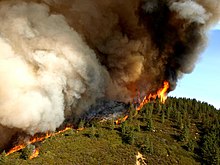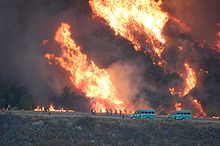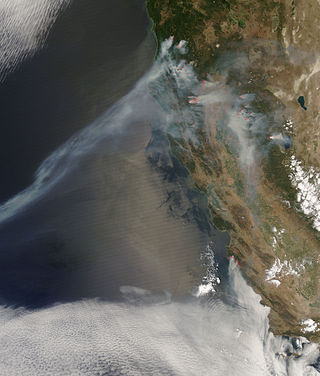
The 2008 California wildfire season was one of the most devastating in the state of the 21st century. While 6,255 fires occurred, about two-thirds as many as in 2007, the total area burned— 1,593,690 acres —far exceeded that of previous years.

Bushfires in Australia are a widespread and regular occurrence that have contributed significantly to shaping the nature of the continent over millions of years. Eastern Australia is one of the most fire-prone regions of the world, and its predominant eucalyptus forests have evolved to thrive on the phenomenon of bushfire. However, the fires can cause significant property damage and loss of both human and animal life. Bushfires have killed approximately 800 people in Australia since 1851, and billions of animals.

The 2014 King Fire was a large wildfire in El Dorado County, California, which burned 97,717 acres primarily in the Eldorado National Forest. The wildfire started on September 13, 2014, near Pollock Pines, California, to the east of Sacramento. The ensuing fire suppression effort, which cost more than $100 million and engaged more than 8,000 personnel at its peak, allowed for the full containment of the King Fire by October 9, 2014. Despite the size and ferocity of the fire, it caused no deaths. Eighty structures were destroyed, the majority of them outbuildings. The King Fire was determined to have been caused by an act of arson and a suspect was swiftly apprehended and convicted in 2016.

In terms of property damage, 2017 was the most destructive wildfire season on record in California at the time, surpassed by only the 2018 season and the 2020 season, with a total of 9,560 fires burning 1,548,429 acres (6,266.27 km2) of land, according to the California Department of Forestry and Fire Protection, including five of the 20 most destructive wildland-urban interface fires in the state's history. Throughout 2017, the fires destroyed or damaged more than 10,000 structures in the state, a higher tally than the previous nine years combined. State data showed that the large wildfires killed 47 people – 45 civilians and 2 firefighters – almost higher than the previous 10 years combined. The total property damage and total amount of burned land were both surpassed by the 2018 California wildfires.

The 2017 wildfire season involved wildfires on multiple continents. On Greenland, which is mostly covered by ice and permafrost, multiple fires occurred in melted peat bogs, described as "unusual, and possibly unprecedented". Popular media asked whether the wildfires were related to global warming. Research published by NASA states "climate change has increased fire risk in many regions", but caused "greater severity in the colder latitudes" where boreal and temperate forests exist, and scholars have described "a warm weather fluctuation that has become more frequent in recent decades" related to wildfires, without naming any particular event as being directly caused by global warming.

The October 2017 Northern California wildfires, also known as the Northern California firestorm, North Bay Fires, and the Wine Country Fires were a series of 250 wildfires that started burning across the state of California, United States, beginning in early October. Twenty-one became major fires that burned at least 245,000 acres (99,148 ha).

A series of 29 wildfires ignited across Southern California in December 2017. Six of the fires became significant wildfires, and led to widespread evacuations and property losses. The wildfires burned over 307,900 acres (1,246 km2), and caused traffic disruptions, school closures, hazardous air conditions, and power outages; over 230,000 people were forced to evacuate. The largest of the wildfires was the Thomas Fire, which grew to 281,893 acres (1,140.78 km2), and became the largest wildfire in modern California history, until it was surpassed by the Ranch Fire in the Mendocino Complex, in the following year.
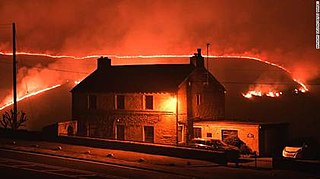
2019 United Kingdom wildfires were a series of wildfires that began on 26 February 2019 and ended on 18 May 2019. The series of wildfires was considered unusual due to the fact that they took place early in the year. Areas affected by the wildfires in 2019 included those that had already been burnt by wildfires during the summer of 2018. The fires have created many air pollution problems for the UK. The causes of most of the fires have been attributed to much higher than average temperatures and drought conditions that have prevailed since the spring of 2018. There were 137 wildfires larger than 25 hectares (250,000 m2) recorded in the United Kingdom in 2019. This beats the previous record of 79 from 2018.
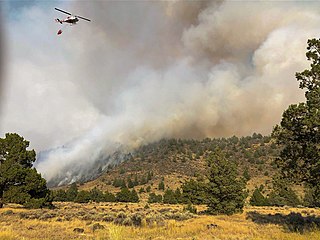
The Tucker Fire was a wildfire that burned near Clear Lake National Wildlife Refuge in Modoc County, California in the United States. The fire ignited on Sunday, July 28, 2019 along Highway 139 and went on to burn an estimated 14,217 acres of land. As of August 15, the fire was 95% contained. Officials say the wildfire was caused by traffic on Highway 139.

The 2019–20 Australian bushfire season or Black Summer was one of the most intense and catastrophic fire seasons on record in Australia. It included a period of bushfires in many parts of Australia, which, due to its unusual intensity, size, duration, and uncontrollable dimension, was considered a megafire by media at the time. Exceptionally dry conditions, a lack of soil moisture, and early fires in Central Queensland led to an early start to the bushfire season, beginning in June 2019. Hundreds of fires burnt, mainly in the southeast of the country, until May 2020. The most severe fires peaked from December 2019 to January 2020.

The 2020 California wildfire season, part of the 2020 Western United States wildfire season, was a record-setting year of wildfires in California. By the end of the year, 9,917 fires had burned 4,397,809 acres (1,779,730 ha), more than 4% of the state's roughly 100 million acres of land, making 2020 the largest wildfire season recorded in California's modern history, though roughly equivalent to the pre-1800 levels which averaged around 4.4 million acres yearly and up to 12 million in peak years. California's August Complex fire has been described as the first "gigafire", burning over 1 million acres across seven counties, an area larger than the state of Rhode Island. The fires destroyed over 10,000 structures and cost over $12.079 billion in damages, including over $10 billion in property damage and $2.079 billion in fire suppression costs. The intensity of the fire season has been attributed to a combination of more than a century of poor forest management and higher temperatures resulting from climate change.

The 1974–75 Australian bushfire season is a series of bushfires, also known around the world as wildfires, that burned across Australia. Fires that summer burned up an estimated 117 million hectares. Approximately 15% of Australia's land mass suffered "extensive fire damage" including parts of New South Wales, the Northern Territory, Queensland, South Australia and Western Australia.

The August 2020 California lightning wildfires were a series of 650 wildfires that ignited across Northern California in mid-August 2020, due to a siege of dry lightning from rare, massive summer thunderstorms, which were caused by an unusual combination of very hot, dry air at the surface, dry fuels, and advection of moisture from the remains of Tropical Storm Fausto northward into the Bay Area. These fires burned between 1,500,000 acres (6,100 km2) to 2,100,000 acres (8,500 km2) within a 2–3 week period. The August 2020 lightning fires included three enormous wildfires: the SCU Lightning Complex, the August Complex, and the LNU Lightning Complex. On September 10, 2020, the August Complex set a record for the single-largest wildfire in the modern history of California, reaching a total area burned of 471,185 acres (1,907 km2). On September 11, the August Complex merged with the Elkhorn Fire, another massive wildfire of 255,039 acres (1,032 km2), turning the August Complex into a monster wildfire of 746,607 acres (3,021 km2).

The 2022 California wildfire season was a series of wildfires throughout the U.S. state of California. By the end of the year, a total of 7,667 fires had been recorded, totaling approximately 363,939 acres across the state. Wildfires killed nine people in California in 2022, destroyed 772 structures, and damaged another 104. The 2022 season followed the 2020 and 2021 California wildfire seasons, which had the highest and second-highest (respectively) numbers of acres burned in the historical record, with a sharp drop in acreage burned.

In June through August 2022, parts of Europe, the Middle East and North Africa were affected by wildfires. The bulk of the fires affected Mediterranean Countries, with the main areas affected being Algeria, France, Greece, Portugal and Spain.

The 2000 California wildfire season was a series of wildfires that burned throughout the U.S. state of California during 2000. According to California Department of Forestry and Fire Protection statistics, 7,622 fires burned a total of 295,026 acres. Cal Fire wildfire suppression costs for fires that burned within the agency's jurisdiction amounted to $109 million. Damages for the same amounted to $87.3 million, with a total of 389 structures lost. The largest wildfires of the year in California were the Manter and Storrie fires, which burned 74,000 and 55,000 acres in Tulare and Plumas counties respectively.

